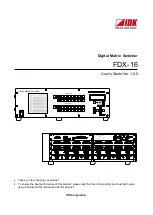
Chapter 13
| Basic Administration Protocols
Ethernet Ring Protection Switching
– 457 –
The version number is automatically set to “1” when a ring node, supporting
only the functionalities of G.8032v1, exists on the same ring with other nodes
that support G.8032v2.
When ring nodes running G.8032v1 and G.8032v2 co-exist on a ring, the ring ID
of each node is configured as “1”.
In version 1, the MAC address 01-19-A7-00-00-01 is used for the node identifier.
The R-APS Def MAC parameter has no effect.
◆
MEG Level
– The maintenance entity group (MEG) level which provides a
communication channel for ring automatic protection switching (R-APS)
information. (Range: 0-7)
This parameter is used to ensure that received R-APS PDUs are directed for this
ring. A unique level should be configured for each local ring if there are many R-
APS PDUs passing through this switch.
◆
Control VLAN
– A dedicated VLAN used for sending and receiving E-APS
protocol messages. (Range: 1-4094)
Configure one control VLAN for each ERPS ring. First create the VLAN to be used
as the control VLAN (see
“Configuring VLAN Groups” on page 156
), add the ring
ports for the east and west interface as tagged members to this VLAN (see
“Adding Static Members to VLANs” on page 159
), and then use this parameter
to add it to the ring.
The following restrictions are recommended to avoid creating a loop in the
network or other problems which may occur under some situations:
■
The Control VLAN must not be configured as a Layer 3 interface (with an IP
address), a dynamic VLAN (with GVRP enabled), nor as a private VLAN.
■
In addition, only ring ports may be added to the Control VLAN. No other
ports can be members of this VLAN.
■
Also, the ring ports of the Control VLAN must be tagged.
Once the ring has been activated, the configuration of the control VLAN cannot
be modified. Use the Admin Status parameter to stop the ERPS ring before
making any configuration changes to the control VLAN.
◆
Node State
– Refer to the parameters for the Show page.
◆
Node Type
– Shows ERPS node type as one of the following:
■
None
– Node is neither Ring Protection Link (RPL) owner nor neighbor.
(This is the default setting.)
■
RPL Owner
– Specifies a ring node to be the RPL owner.
■
Only one RPL owner can be configured on a ring. The owner blocks
traffic on the RPL during Idle state, and unblocks it during Protection
state (that is, when a signal fault is detected on the ring or the
Содержание GTL-2881
Страница 30: ...Figures 30 Figure 450 Showing RIP Peer Information 669 Figure 451 Resetting RIP Statistics 670 ...
Страница 34: ...Section I Getting Started 34 ...
Страница 48: ...Section II Web Configuration 48 Unicast Routing on page 651 ...
Страница 151: ...Chapter 4 Interface Configuration VLAN Trunking 151 Figure 69 Configuring VLAN Trunking ...
Страница 152: ...Chapter 4 Interface Configuration VLAN Trunking 152 ...
Страница 229: ...Chapter 8 Congestion Control Automatic Traffic Control 229 Figure 135 Configuring ATC Interface Attributes ...
Страница 230: ...Chapter 8 Congestion Control Automatic Traffic Control 230 ...
Страница 596: ...Chapter 14 Multicast Filtering Multicast VLAN Registration for IPv6 596 ...
Страница 620: ...Chapter 15 IP Configuration Setting the Switch s IP Address IP Version 6 620 ...
Страница 670: ...Chapter 18 Unicast Routing Configuring the Routing Information Protocol 670 Figure 451 Resetting RIP Statistics ...
Страница 672: ...Section III Appendices 672 ...
Страница 678: ...Appendix A Software Specifications Management Information Bases 678 ...
Страница 688: ...Appendix C License Statement GPL Code Statement Notification of Compliance 688 ...
Страница 696: ...Glossary 696 ...
Страница 706: ...GTL 2881 GTL 2882 E112016 ST R01 ...
















































